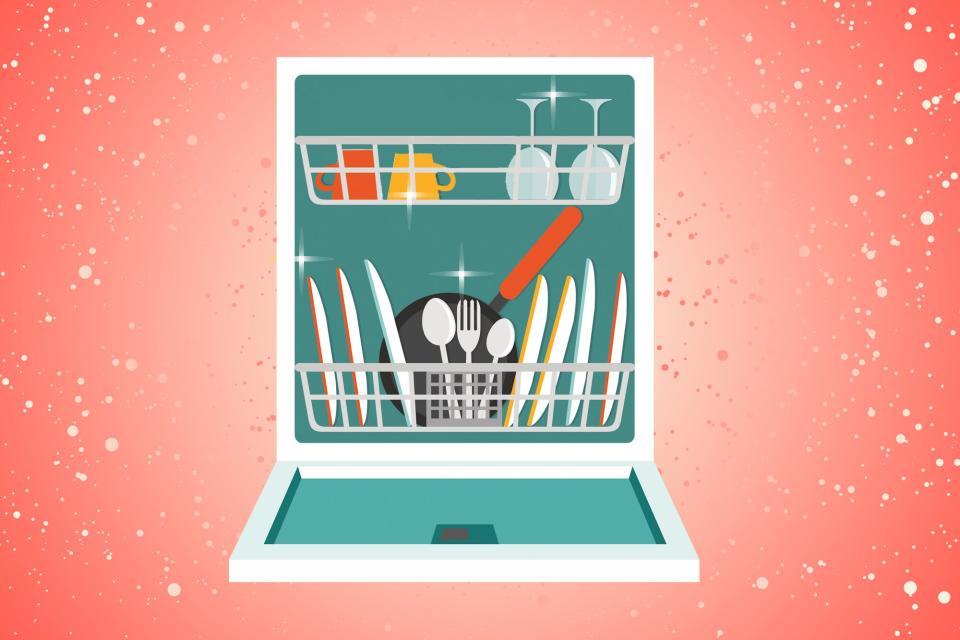6 Dishwasher Mistakes You're Probably Making
We've all been in this situation before: the kitchen sink is full of dirty dishes and you're dreading cleaning them. If you're lucky, though, you can skip the headache and hassle and turn to your trusty dishwasher instead. But before you load it up, here are six dishwasher mistakes you may be making—plus what to do instead so this tedious household chore becomes effortless.
Mistake #1: You Pre-Rinse Your Dishes
If you grew up thinking that dishes had to be rinsed before they went into the dishwasher, you're not alone. In actuality, pre-rinsing dishes can have a negative impact on the washing cycle. That's because some dishes may be pre-rinsed better than others, which could lead the dishwasher's sensor into thinking it doesn't need to run as intense a cycle. As a result, you may end up with some dishes that need to be rewashed. Instead, the best practice is to scrape off any food on the dishes and then load them as is.

Getty Images
Mistake #2: You Put the Detergent Pod in the Main Area of the Dishwasher
You may have heard of people putting their detergent pods in the main dishwasher area as opposed to the dispenser area, but is that the right placement? We reached out to Morgan Eberhard, senior scientific communications manager at Procter & Gamble (parent company of Cascade), who helped set the record straight.
"If users are placing the pod correctly in the dispenser cup, the detergent will be released near the beginning of the main wash and therefore in contact with the dirty dishes for the full main wash cycle. If users toss the pod into the bottom of the machine or into the cutlery basket, the product is only in there for 10 to 15 minutes, then 80% of it drains away with the prewash cycle water, meaning the rest of the dishwasher cycle is getting washed with only about 20% of the product," explains Eberhard.
So the next time you run a cycle, be sure to place the detergent pod (or powder or gel) in the dispenser area, not the main area. After all, it's there by design.
Mistake #3: You Think It's a Waste of Water to Run a Small Load So You Hand-Wash Them Instead
While it may seem efficient to hand-wash dishes after a meal, especially if you only have a few to clean, it's a more sustainable choice to use the dishwasher. In fact, some newer models of dishwashers may have a small-load setting. "Most Americans spend 11 minutes a day washing dishes under a running tap, wasting up to 24 gallons of water!" says Eberhard. "By comparison Energy Star-certified dishwashers use less than 4 gallons of water per cycle." As a rule of thumb, Eberhard recommends using the dishwasher if you have more than eight dishes to clean. So skip the scrubbing and load up your dishwasher instead—your water and energy bill will thank you.
Mistake #4: You Overcrowd the Dishwasher
Loading the dishwasher is often a puzzle, and one mistake that you definitely want to avoid is overcrowding it. The water from the spray arms needs to be able to reach every item, so stacking items on top of each other or cramming just one more container on the top rack will make it more likely you'll end up with half-cleaned dishes. Instead, stick to the designated slots and spokes in the dishwasher.
Related: 8 Kitchen Items That Should Never Go in Your Dishwasher
Mistake #5: You Organize Items Incorrectly in the Dishwasher
To go along with overcrowding the dishwasher, another mistake you may be making is organizing the items incorrectly. While often debated, there is a right way to load the dishwasher. Items like plates, pots and pans should be placed on the bottom rack, while cups, mugs and bowls are best situated face-down on the top rack. And one area to organize extra carefully is the utensil basket.
"By design, spoons like to, well, spoon. Try to mix up what type of utensils are in each section of your cutlery basket, so they don't end up resting together," says Eberhard. Doing this will ensure that each utensil is thoroughly cleaned. Some utensil baskets actually feature a grid top to help separate items, so make the most of it. And while you're organizing, forks and spoons should go up in the basket, but knives should face down for safety.
Mistake #6: You Don't Clean Your Dishwasher
Yes, the appliance that cleans your dishes also needs to be cleaned from time to time, too. One important area to clean in your dishwasher is the drain, which can often get clogged with food. Remove the drain and rinse it clean before replacing. To remove any buildup, learn how to clean your dishwasher with vinegar, which can also help remove any lingering odors. It's also recommended to wipe the bottom of the dishwasher where it meets the door, as gunk there can prevent it from running effectively. To keep your appliance in tip-top shape, plan to clean it once a month.
Up Next: 10 Common Kitchen-Cleaning Mistakes You're (Probably) Making

